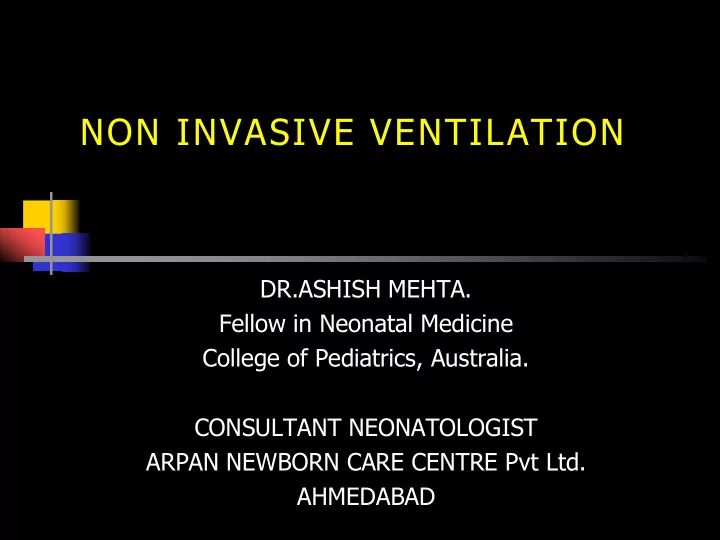

NON INVASIVE VENTILATION DR.ASHISH MEHTA. Fellow in Neonatal Medicine College of Pediatrics, Australia. CONSULTANT NEONATOLOGIST ARPAN NEWBORN CARE CENTRE Pvt Ltd. AHMEDABAD
Mammalian Birth is Similar to Amphibian Metamorphosis Transition from an aquatic existence to an obligate air breathing state Profound functional and structural adjustments in all organ systems Top of Mount Everest to sea level in a second
Functional Residual Capacity Hooper SB et al, NeoReviews, 2010
Oxygen saturation in healthy term infants Mariani G et al, J of Peds, 2007
Respiratory support for preterm babies Aim: open the lung and keep it open!
Traditional Classification of Non Invasive Ventilation New Attractions Infant flow driver
Lung volume, lung weight, and protein and DNA contents at end of study were higher in CPAP-exposed than in control animals (all P < 0.01). Strain-induced growth of the immature lung. Zhang S. et al. J. Appl Physiol 1996;81:1471-6
Continuous distending pressure: Maintains upper airway patency Distends lower airways Maintains functional residual capacity (FRC) Preserves surfactant Increases pulmonary compliance Improves gas exchange Regulates breathing pattern Morley CJ. ADC 2003
Success Rate with CPAP
CPAP and Surfactant Less need of MV Lesser duration of MV Decreased oxygen days Reduce CPAP failure rate Less airleak Lesser incidence of CLD Safe
DR CPAP vs Early Surfactant Study N Design Comments COIN 610 25-28 weeks, randomized at 5 No difference in death or BPD, CPAP arm minutes, CPAP 8, FiO2>60% had more PTX and fewer days on MV. (NEJM 2008) Subgroup analysis at 8 weeks showed CPAP arm had improved lung mechanics and decreased WOB SUPPORT 1316 24-27 weeks, randomized at birth, No difference in death or BPD, CPAP arm CPAP 5, FiO2>50% required less intubation, fewer days on MV (NEJM 2010) and less postnatal steroids. Decreased death in the CPAP arm among infants 24-25 weeks CURPAP 208 25-28 weeks, PSX vs Early CPAP No difference in death or morbidities, CPAP 6, FiO2>40% conclude that >50% will only need CPAP (Pediatrics 2010) VON 648 26-29 weeks, PS vs IS vs nCPAP, No difference in mortality or BPD amongst CPAP 5, FiO2 40-60% the 3 groups. nCPAP arm had ~50% (Pediatrics 2011) reduction in intubation rates and need for surfactant
AAP recommendation… Using CPAP immediately after birth with subsequent selective surfactant administration may be considered as an alternative to routine intubation with prophylactic or early surfactant administration in preterm infants. RA Polin, WA Carlo , AAP Pediatrics 2014 Level of evidence 1 : strong recommendation
AAP recommendation… IF respiratory support with a ventilator will be needed…. Early administration of surfactant followed by Rapid extubation is preferable to prolonged ventilation… RA Polin, WA Carlo , AAP Pediatrics 2014 Level of evidence 1 : strong recommendation
Doing CPAP well isn’t all that easy! Prospective study with decubitus score staging Swiss NICU with wide experience in CPAP use CPAP-related Nasal Trauma Nasal occurs in > 40% of VLBWI Neonates Fischer C et al. Arch Dis Child F&N Ed. 2010;95:F447-451
HHHFNC CPAP
Fundamental difference HHHFNC and CPAP – presence of leak ! Effective CPAP requires a HFNC: Leak between good seal/minimal leak cannula and nares is for pressure mandatory! 50-70% transmission!
Wilkinson DJ et al. pharyngreal pressure Result: pressure increases with increasing flow ( p<0.003) Wilkinson D et al. J Perinatol 2008; 28: 47-49
Wilkinson D et al. J Perinatol 2008; 28: 47-49
Conclusion : WOB and pharyngeal pressures comparable between nCPAP and HHHFNC.
Pediatr Pulmonol. 2015; 50:576 – 583.
1112 neonates HHHFNC compared with other modes of NIV when used as primary mode or post extubation
Consensus of evidence High flow equivalent to neonatal CPAP in terms of safety and efficacy Less nasal trauma No clinically significant adverse event More acceptable to patient and family Simpliflies care for the care giver
Not all infants can be supported with Nasal CPAP/HFNC alone 50-60% of infants fail CPAP as initial form of support (Morley, 2008 and SUPPORT TRIAL, 2010) 25-38% of infants fail nCPAP following InSurE (Stefanescu, 2003) Respiratory Failure: pH<7.20, PaO 2 >50 on FiO 2 >0.5, and PaCO 2 >65; or intractable apnea requiring frequent stimulation or manual resuscitation, and high WOB
NIPPV as Primary mode Less failed extubations , Shorter duration of respiratory support Decreased clinical and physiological BPD
(S) NIPPV as secondary mode Less failed extubations , Shorter duration of respiratory support Decreased BPD/death, NDI and NDI/Death
ET tube induced complications Traumatic and painful Hemodynamic instability Infection- Sepsis ↑ Airway emergencies ↑ Resistance/WOB ↑ Incidence of air-leak Permanent airway lesions
Recommend
More recommend